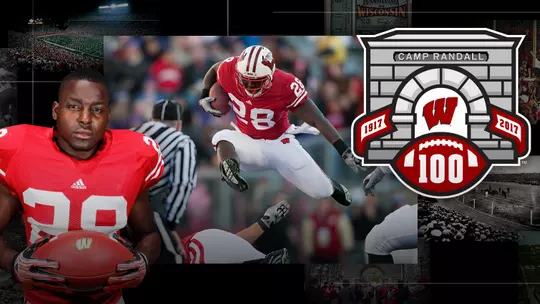
Camp Randall 100: Montee Ball
Record-setting All-American had unique view of Badgers’ tailback tradition
Andy Baggot
7/15/2017
The Camp Randall 100 is an exclusive list celebrating 100 people who have shaped Camp Randall Stadium's history across the realms of sports, music, culture and beyond. A new honoree will be revealed each day over the final 100 days leading up to kickoff of the Wisconsin football team's season opener with Utah State on Friday, Sept. 1. The Camp Randall 100 reveal is part of a year-long celebration of the history of the iconic stadium, which opened in 1917.
MADISON, Wis. — Despite sharing the backfield with three of the most successful running backs in Wisconsin football history, Montee Ball found a way to distinguish himself as one of the best at a position with a storied history at UW.
Playing alongside John Clay, Melvin Gordon and James White during his time in the Badgers' backfield, Ball had a unique view of UW's tradition at tailback.
So what stands out to Ball from a career filled with memorable moments? Read more in his Camp Randall 100 profile below.
Camp Randall 100: Montee Ball
Wisconsin football has an ultra-rich history at the tailback position and no one has a more unique view of it than Montee Ball.
He’s second on the all-time career rushing list at UW, which is remarkable when you know that he crossed paths with No. 3 on that compilation (Melvin Gordon), No. 5 (James White) as well as No. 10 (John Clay).
In other words, Ball, who played for the Badgers from 2009 to ’12, competed directly for playing time against peers who combined for six 1,000-yard seasons and 58 100-yard rushing performances.
Ball had two 1,000-yard seasons, in 2011 and ’12, but so did Clay (2009, ’10), White (2010, ’13) and Gordon (2013, ’14).
Ball was a first-team All-American in 2011 and ’12, but so was Gordon in 2014.
Ball was a first-team All-Big Ten Conference selection in 2011 and ’12, but so were Clay in 2009 and Gordon in 2014.
Ball was the Doak Walker Award winner in 2012, but so was Gordon in 2014.
Ball was a Heisman Trophy finalist in in 2011, but so was Gordon in ’14.
Ball has the unique distinction of having rushed for 100 yards in the same game as Clay, White and Gordon.
Ball and Gordon also were the first UW backs to rush for 200 yards in the same game.
“That’s what each of us fed on, the competition,” Ball said. “On the field, we were all competing for that spot. Off the field, we were the best of friends.”
All four had shots at NFL jobs, but only White (New England Patriots) and Gordon (Los Angeles Chargers) currently have any traction in the pros.
“They’re still doing amazing things,” Ball said.
During his four record-setting seasons as a UW tailback, Montee Ball played in 23 games and had 434 touches at Camp Randall Stadium.
Ball was responsible for 40 touchdowns — 38 on the ground, one via reception, one via pass — in home games during his decorated career.
But one game stands out.
One play stands out, too.
It was Oct. 1, 2011. The unbeaten Badgers, ranked seventh nationally, were hosting Nebraska, ranked eighth.
The Big Ten Conference debut for the Cornhuskers — the five-time national champions had moved over from the Big 12 Conference — was a night-time kickoff with a national TV audience on hand as well as a sellout crowd of 81,384.
“That was a major game for us,” Ball said. “That game really sticks out to me because of just the fact that was our biggest test that year.
“Everything was set up perfectly for us. I believe we showed the country what we’re capable of doing.”
Wisconsin, fortified by one of the most lethal offenses in program history, rolled to a 48-17 victory.
UW stared down two earlier deficits before rattling off five unanswered touchdowns to pull away.
Leading the way were Ball, who carried 30 times for 151 yards and four TDs, and quarterback Russell Wilson, who was 14-for-20 for 255 yards and two scores.
It was one of six times in his career that Ball scored four touchdowns. Four of those performances came in 2011 when he tied a Football Bowl Subdivision record with 39 TDs in a single season.
Ball also led the nation with 1,923 rushing yards in 2011 and was a finalist for the Heisman Trophy.
By the time Ball was finished, he amassed 5,140 rushing yards — second in school history to 1999 Heisman winner Ron Dayne — and a then-FBS record 83 career TDs (77 rushing, six receiving).
There was a lot of hype leading up to that Nebraska game in 2011. Ball remembers the Cornhuskers doing a lot of chirping.
“I’m never one to speak poorly of a team or their ways of preparing,” he said. “In the game of football, you do need a bunch of confidence.
“But, yes, they were talking a lot. They were doing a lot of talking leading up to the game.”
Ball said Wilson, a future Super Bowl-winning quarterback with Seattle, did a good job of keeping everyone’s mind locked in on the task at hand.
“We just focused on keeping our mouths shut,” Ball said.
The UW defense helped lay the foundation for the blowout by intercepting Nebraska quarterback Taylor Martinez three times, turnovers the Badgers converted into 21 points.
Gallery: Camp Randall 100: Montee Ball
The play that Ball recalled most fondly came in the fourth quarter and resulted in his fourth TD of the night.
On second-and-12 from the Nebraska 15, Ball took a handoff from Wilson and churned to his right only to run into one his own linemen.
Ball made a quick jump cut and angled toward the left sideline. There he picked up Wilson as a blocker and picked his way to the end zone.
Ball said it was a symbolic sequence that demonstrated Wilson’s penchant for leading by example.
Earlier in the 13-play drive, as the Camp Randall crowd rocked to “Sweet Caroline” during a timeout, Wilson gathered his offensive teammates around him and implored everyone to stay in the moment.
The ensuing touchdown finished off a 73-yard drive that spanned 8 minutes, 15 seconds.
“We put a stamp on the game and what type of team we are and took away the hearts of Nebraska,” Ball said. “It was a remarkable game.”
The Badgers hit a rough patch the next two weeks — last-minute losses at Michigan State and Ohio State — but they regrouped to win the second of three straight Big Ten titles.



















